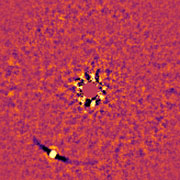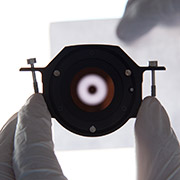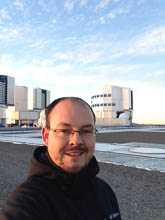About Me
I am a permanent CNRS researcher based at Laboratoire d'Astrophysique de Marseille (France). In 2015, I spent one year at the European Southern Observatory in Chile, where I was co-instrument scientist of the VLT/SPHERE instrument. My research interest is the direct detection and characterisation of exoplanets, and the development of high-contrast instrumentation for this purpose. Direct imaging of young giant exoplanets has entered a new era thanks to the new generation of dedicated instruments that started operations on some of the largest ground-based telescopes in 2014-2015. I am part of the large consortium who has designed and built the SPHERE planet imager for the Very Large Telescope, and has used it to perform the large SHINE survey. The goal of SHINE was to look for new planets and place strong constraints on their formation mechanisms.
I was also the PI of the ERC project HiRISE, which has implemented a coupling between SPHERE and CRIRES at the VLT to enable the characterisation of young giant exoplanets at very high spectral resolution. The instrument was successfully installed at the VLT during the summer 2023 and has now entered regular science observations.
Detection and characterisation of exoplanets

High-contrast imaging is the best method to detect the intrinsic light of giant exoplanets in the near-infrared around nearby young stars. Over the years, I have been involved in several large-scale observing programmes looking for new planets and brown dwarfs, such as the NaCo Large Programme (NaCo-LP) collaboration or the International Deep Planet Search (IDPS). The goal of these surveys was not only to detect and characterise new companions, but also to bring constraints on their population, such as their overall frequency and the distribution of their physical parameters. I had a central position in the 200-nights SPHERE/SHINE survey in the near-infrared, and during which we are observing several hundreds of stars covering a wide range of spectral type, age and distance. The survey has been conducted from 2015 to 2023 and has provided several high-impact results, including two new planets, HIP 65426 b and PDS 70 b. In 2021, I published the preliminary statistical analysis of the survey. With HiRISE I am now largely involved into the characterisation of known exoplanets and brown-dwarfs with high-resolution spectroscopy. I am leading a large collaboration, MIRAGES, funded by the French ANR agency, which aims at exploring the multi-resolution characterisation of companions to understand their physics and formation processes. In the context of MIRAGES, we are executing the HiRISE large programme, with more than 20 nights of observations in 2023-2025. We recently published the first analysis of the AF Lep b companion at high spectral resolution.
Development of high-contrast instrumentation

Detecting the faint signal of young exoplanets at very small angular separation from bright stars is extremely challenging. It requires a very specific instrumentation based on extreme adaptive optics, high-efficiency coronagraphs, fine wavefront control and advanced data analysis methods. I am working on several of these different aspects to develop new instrumentation dedicated to the detection and characterisation of exoplanets. I have participated in the design, development and testing of two instruments for the VLT. The first one is the Active Phasing Experiment (APE), a visitor instrument dedicated to the cophasing of segmented primary mirrors for Extremely Large Telescopes (ELTs), which was tested on-sky in 2008-2009. The second one is the new generation instrument SPHERE, which is entirely dedicated to the direct detection of young giant exoplanets. Since 2012, I am deputy instrument scientist of the SPHERE infrared dual-band imager and spectrograph (IRDIS), for which I have been responsible for the dual-band imaging (DBI) and long-slit spectroscopy (LSS) modes. I am now working on various methods to improve high-contrast imaging instrumentation, mainly the use of the ZELDA wavefront sensor to compensate the instrumental non-common path aberrations (NCPA) or for segment phasing, and the coupling of high-contrast imaging and high-dispersion spectroscopy (ERC HiRISE). I am also the CNES representative in the Coronagraph instrument of the Roman Space Telescope (RST), which will, for the first time, demonstrate active wavefront correction for extremely high-contrast imaging in space.


